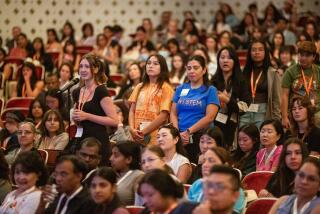Pioneer Helps Generations of Women Aim for Stars
- Share via
NEW HAVEN, Conn. — At age 90, Dorrit Hoffleit secures her bifocals over cloudy eyes and looks to the sky. Only the heavens can yield the answers to questions she has devoted her life to solving.
But even with the glasses and a powerful telescope, the famous astronomer can no longer see what she wants to see. The retired Yale professor’s view of the cosmos has been dimmed by cataracts, yet she continues to work on a historical survey of astronomical data.
“Most people work for a living. I live in order to work. It’s what I love to do,” Hoffleit said.
Those who know her best--her proteges--say Hoffleit’s diligence and commitment to the field led them to become astronomers.
“Where I am today and what I am today, I owe it all to her,” said Janet Mattei, 54, director of the American Assn. of Variable Star Observers. “She was such a role model. She influenced my whole life and career.”
Hoffleit has been credited with encouraging generations of women to aim for the stars, and she wrote one of the most used catalogs of the cosmos.
Astronomers from the United States and Canada recently gathered at a two-day symposium at Yale to pay tribute to their mentor and honor her astronomical achievements.
“Encouraging would really be the word I would use for her,” said Nancy Houk, 56, an astronomer at the University of Michigan who credits Hoffleit with getting her started back in 1962. “A lot of what we lacked was confidence, and she gave us that.”
Though she officially retired more than 20 years ago, she still goes into the office every day at 8:30 a.m. and often doesn’t leave until 7 p.m. Hoffleit joined the Yale faculty in 1956; she now holds the title of senior research astronomer.
With her bohemian-style clothing and long gray hair suspended in a loose bun, Hoffleit looks younger than her years. She never married; her first and only love is the stars. And she says without embarrassment that she has no hobbies--except her work.
Last year, she and Yale colleagues William F. van Altena and John T. Lee finished an 18-year project by publishing the fourth edition of “The General Catalogue of Trigonometric Stellar Parallaxes.”
Astrophysicists worldwide depend upon its precise measurements of distances to 8,112 stars to explore questions about stellar evolution and the size and age of the universe.
In 1982, Hoffleit documented 9,110 stars that are visible to the naked eye in her book “The Bright Star Catalogue,” a map that leads scientists and amateurs alike to the stars.
Scientists recognize her for the quality of her data on the brightest stars and for observations of stars with variable brightness.
“I think almost all of us here have that bright blue catalog, and all of us know in our sleep where it is in our library,” Mattei said.
Born March 12, 1907, in Florence, Ala., Hoffleit thought as a youngster that she would become an artist.
“I always was interested in shooting stars as a child, but it never occurred to me to become an astronomer. I just thought, ‘The sky is beautiful and you see it. So what?’ ”
She said she stumbled onto astronomy in college. After receiving an undergraduate degree in mathematics from Radcliffe, she got an offer to become a high-paying statistician. But then she heard about an opening at the Harvard College observatory.
“It was terribly exciting. Exploration and discovery, that’s what the job was,” she said with a smile. “It’s much better to pick the job you like than the one that pays more.”
She began her career in 1929 as a research assistant and astronomer at the observatory. She earned a doctorate in astronomy under the direction of the famous Harvard astronomer Harlow Shapley. Though she had tenure, she left in 1956 after Shapley retired.
During World War II, she worked as a mathematician at the Ballistic Research Laboratories at the Aberdeen Proving Ground in Maryland, where she protested that women weren’t allowed to earn professional salaries.
When she became director of the Maria Mitchell Observatory in Nantucket, Mass., in 1957, she got her chance to help other women.
The observatory is a memorial to America’s first woman astronomer, and while she was there, Hoffleit created a summer program for women undergraduates in astronomy.
Among the 102 students she had over 21 summers, more than 20 have doctorates in astronomy and dozens of others are still in the field.
“It was a real first step for a lot of us, the first time many of us could see that you could actually have a career in astronomy,” said Nancy Remage Evans, an astrophysicist with the Smithsonian Astrophysical Observatory at Harvard.
Evans, who was on Nantucket in the summer of 1964, said she is always surprised to find how many women astronomers spent a summer with Hoffleit.
As a new generation of women look to the stars, Hoffleit said uncharted territory will be out there long after her career has ended.
“When it comes to astronomy, you never come to the end of anything,” she said. “You have to reach out farther and farther into the universe. If it’s infinite, then there is no limit.”






